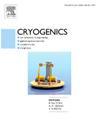Design and operation of direct heat exchange type thermal energy storage unit in an actual-size liquid air energy storage system
IF 1.8
3区 工程技术
Q3 PHYSICS, APPLIED
引用次数: 0
Abstract
This study examines the design specifications and operational parameters crucial for integrating thermal energy storage unit (TESU) within a demonstration-scale liquid air energy storage (LAES) system. The LAES system’s storage capacity of 6 MWh and power generation of 2 MW serve as performance benchmarks. To satisfy these criteria, a TESU with a mass flow rate of 26 kg/s and a duration of 2 hr to 4 h is deemed essential. Ensuring an effectiveness exceeding 0.9 necessitates adherence to specific design principles. Firstly, optimal spatial configuration of heat exchange parts, approximately double the thermal penetration depth, is essential to maintain high performance. Deviations from this guideline can lead to decreased heat exchange efficiency and thermal interference. Moreover, as TESU duration increases, the relative heat capacity of the shuttle mass rises, diminishing overall effectiveness. Adequate heat capacity within the TESU is thus crucial to sustaining desired performance levels throughout the duration. Additionally, optimizing the aspect ratio of the TESU improves effectiveness by mitigating axial heat conduction losses, facilitating efficient energy storage and retrieval. By incorporating these design considerations, the performance and effectiveness of the TESU within LAES systems can be optimized, enabling seamless energy management.

实际规模液体空气储能系统中直接换热式蓄热机组的设计与运行
本研究考察了在示范规模的液体空气储能(LAES)系统中集成热储能单元(TESU)的关键设计规范和操作参数。LAES系统的存储容量为6兆瓦时,发电量为2兆瓦,作为性能基准。为了满足这些标准,一个质量流量为26kg /s,持续时间为2小时至4小时的TESU被认为是必不可少的。确保效率超过0.9需要遵守特定的设计原则。首先,换热部件的最佳空间配置,大约是热渗透深度的两倍,对于保持高性能至关重要。偏离此准则会导致热交换效率降低和热干扰。此外,随着TESU持续时间的增加,航天飞机质量的相对热容上升,降低了整体效率。因此,在整个持续时间内,TESU内足够的热容量对于维持所需的性能水平至关重要。此外,优化TESU的长径比可以通过减少轴向热传导损失来提高效率,促进高效的能量储存和回收。通过整合这些设计考虑因素,可以优化LAES系统中TESU的性能和效率,实现无缝的能源管理。
本文章由计算机程序翻译,如有差异,请以英文原文为准。
求助全文
约1分钟内获得全文
求助全文
来源期刊

Cryogenics
物理-热力学
CiteScore
3.80
自引率
9.50%
发文量
0
审稿时长
2.1 months
期刊介绍:
Cryogenics is the world''s leading journal focusing on all aspects of cryoengineering and cryogenics. Papers published in Cryogenics cover a wide variety of subjects in low temperature engineering and research. Among the areas covered are:
- Applications of superconductivity: magnets, electronics, devices
- Superconductors and their properties
- Properties of materials: metals, alloys, composites, polymers, insulations
- New applications of cryogenic technology to processes, devices, machinery
- Refrigeration and liquefaction technology
- Thermodynamics
- Fluid properties and fluid mechanics
- Heat transfer
- Thermometry and measurement science
- Cryogenics in medicine
- Cryoelectronics
 求助内容:
求助内容: 应助结果提醒方式:
应助结果提醒方式:


